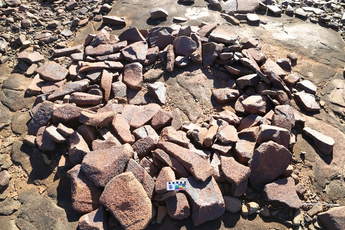

Emma Beckett
Stone structures, features and arrangements are important, geographically fixed archaeological resources. These are anthropogenically moved or placed stone which range from symbolic arrangements of highly cultural significance to structures that reflect a broad range of subsistence behaviours.
A new classificatory system has been developed that provide a flexible method for defining Murujuga stone structures. This advocates a form-first approach with a focus on recognisable and standardised terminology that identifies first how the structures were created and then aims to interpret how they were used (i.e. their function).

This typology was developed and tested on a sample of 2,940 Murujuga structures, 502 of which were recorded during the Dynamics of the Dreaming project.
Nine stone structure types are defined: modified gnammas, discrete placed stones, standing stones (such as the one pictured left), clusters or piles, barriers, landscape walls, clearings or enclosures, bedrock pits and historical structures.
These definitions are based on three key attributes: construction, landscape context and form.
Structures recorded during the MLP reflect the project’s target areas. Many structures were recorded on Rosemary Island where they appear in higher numbers and densities than in the target areas on Enderby Island.
The interior of four circular cleared structures were excavated: at the Old Geos site and one on Rosemary Island; and two on Enderby Island (see image right prior to excavation).
Three of these can be defined as domestic habitation structures. The Gidley Island and West Lewis Island structures are mostly historical pastoral and pearling features. A number of these structures were also excavated.

Click on each photo to learn more
All photographs within this monograph were taken by CRAR+M researchers, partners and students, and have been given cultural approval for publication by Murujuga Aboriginal Corporation. Future use of imagery would require additional permissions from Murujuga Aboriginal Corporation and CRAR+M.
© 2022. This work is licensed under a
















